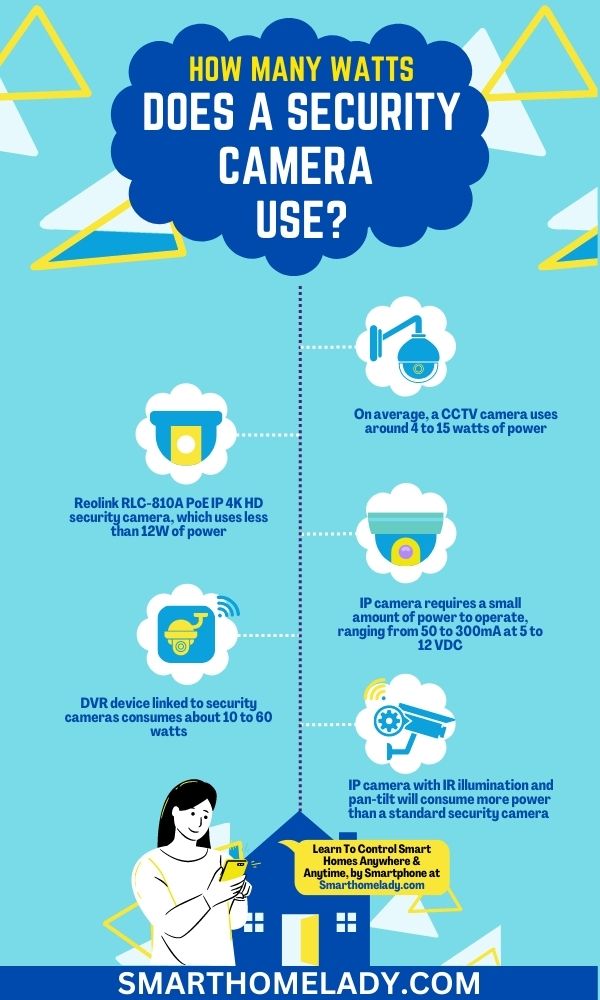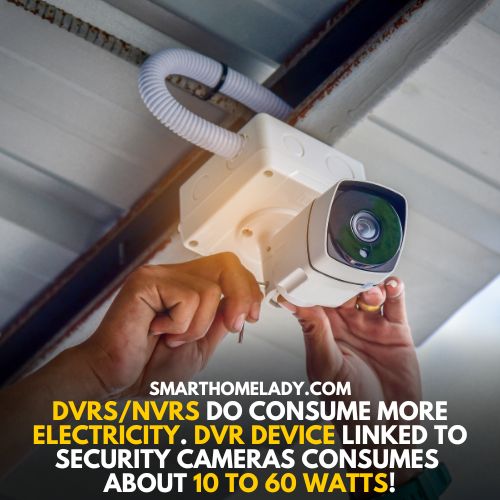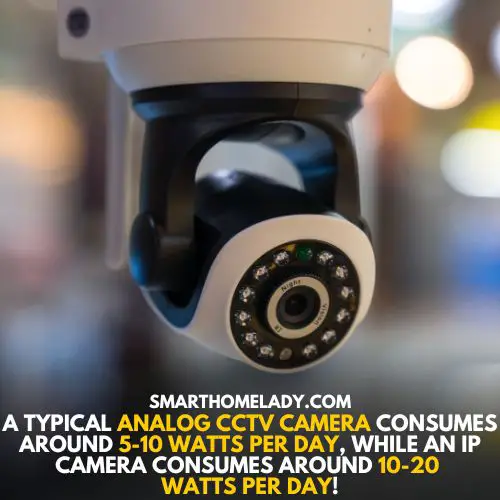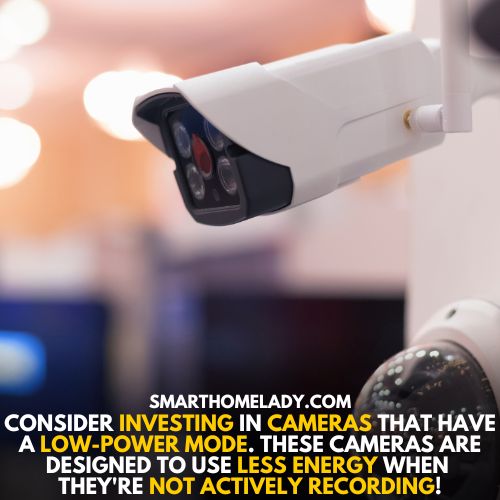CCTV cameras have become an essential component of modern-day security systems, keeping us safe and secure. As you may know, CCTV cameras are designed to operate 24/7, which means they need a constant source of power to keep them operational.
Given the rising concern over energy usage and its impact on the environment, it’s no surprise that people are starting to ask questions about the power consumption of these surveillance cameras.
In this article, we’ll take a closer look at how much power does a CCTV camera use, and what factors can affect their energy usage.
So, if you’re curious about how much electricity your CCTV camera is using, let’s discuss it.

Contents
- 1 How Many Watts Does A CCTV Camera Use – Quick Answer
- 2 CCTV Camera Power Consumption Calculator
- 3 Does DVR/NVR Use a Lot of Electricity – DVR/NVR Power Consumption
- 4 Comparison of Power Usage Among Different Camera Models
- 5 CCTV Power Consumption Per Day
- 6 Hikvision CCTV Camera Power Consumption
- 7 pTZ camera power consumption
- 8 What is The Wattage of a CCTV Camera and How Can You Find It?
- 9 How to Reduce Power Consumption of CCTV Cameras?
- 10 How many amps does a 12V CCTV camera use?
- 11 How Many Watts Do Your Security Cameras Use?
- 12 How much electricity does CCTV cameras use?
- 13 How much electricity does a light bulb security camera use?
- 14 Does CCTV consume a lot of electricity?
- 15 How much is Hikvision 2mp camera power consumption?
- 16 How many watts does an IP camera draw? IP Camera Power Consumption
- 17 Conclusion
- 18 Sources
How Many Watts Does A CCTV Camera Use – Quick Answer
Home security cameras are a must-have for securing your property, but their power consumption is something you should consider before making a purchase.
The type of camera, its features, and how it’s connected to the power supply all affect the power consumption.
On average, a CCTV camera uses around 4 to 15 watts of power, while the DVR device linked to it consumes about 10 to 60 watts.
However, each CCTV camera comes with its own power consumption specifications, like the Reolink RLC-810A PoE IP 4K HD security camera, which uses less than 12W of power, making it an energy-efficient option.
As a security camera enthusiast, it’s important to understand the varying power consumption of different camera features.
For instance, an IP camera with IR illumination night vision and pan-tilt will consume more power than a standard CCTV or IP security camera without these features. You can expect around a 2-4 watt increase in power consumption.
Typically, an IP camera requires a small amount of power to operate, ranging from 50 to 300mA at 5 to 12 VDC.
On the other hand, an NVR, which is often used to record footage from multiple cameras, consumes significantly more power at around 3000mA @ 12VDC.
When it comes to calculating the power consumption of your security cameras, there’s a simple formula you can use. Just multiply the voltage (V) by the current (I) to get your power consumption.
For example, if your camera has a voltage of 12 and a current of 0.5, your power consumption would be 6 watts (12 x 0.5 = 6).
You can calculate the Power Consumption of security cameras by using my calculators too.
Use My Surveillance Camera Or
CCTV Camera Power Consumption Calculator
Does DVR/NVR Use a Lot of Electricity – DVR/NVR Power Consumption
Yes, DVR/NVR does use a considerable amount of electricity. As a Smart home security expert, I can tell you that DVRs/NVRs do consume more electricity. But before you start worrying, let me explain something.
Without POE and HDD, an NVR will only draw under 10-15 watts of power. However, if you add in some drives and POE, it can go up to 40-50 watts.

Now, if your camera is using 50-60 watts of power at $0.08/KW that could cost you around $29-30 per year. Still with me?
Now here’s where things get interesting – if you opt for a PC-based NVR setup instead, it’ll consume around 200 watts. That’s roughly $100-120 per year just on energy costs alone.
So when it comes to choosing the right system for your needs, it’s worth considering these factors.
Moving on to IP cameras – did you know most of them only draw about 4-10 watts of power? This means they’ll cost you roughly $2.50 to $5.0 per year in energy costs.
As for my security camera, it uses around 8 watts which only costs me about $10 annually given my high energy rates. But remember, here I am talking about just one camera. I have 4 cameras, and the power consumption cost of each camera adds up to my monthly bill.
So, choosing the right type of system is essential if you want to keep your energy consumption down and save money in the long run.
Comparison of Power Usage Among Different Camera Models
As I was researching for the best CCTV camera to install in my home, I stumbled upon different brands and models with varying power consumption.
The table below displays the power consumption (in watts) of various camera models and their accompanying DVR systems, if applicable.
| Camera Model | CCTV Camera [W] | DVR system [W] |
|---|---|---|
| TP-Link Tapo C310 | 5.4 Watts | 10 Watts |
| Ring Floodlight Cam | 15 Watts | 12 Watts |
| Wyze Cam | 4 Watts | 10 Watts |
| Google Nest Cam IQ | 13 Watts | 9 Watts |
| Vivint Outdoor | 7 Watts | 13 Watts |
The Ring Floodlight Cam uses significantly more power than the other cameras listed. The Wyze Cam has a relatively low power consumption compared to the others.
The Nest Cam Outdoor is a great option for those who want high-quality footage without sacrificing too much power consumption. It uses 7 watts during the day and up to 13 watts at night when the infrared lights turn on.
So, it is important to consider the power consumption of different camera models when deciding which one to purchase.
CCTV Power Consumption Per Day
The power consumption of a CCTV camera varies depending on its type, resolution, and features.
Generally, a typical analog CCTV camera consumes around 5-10 watts per day, while an IP camera consumes around 10-20 watts per day. However, this estimate may vary depending on the camera’s quality and usage.
It is essential to calculate the power consumption of CCTV cameras accurately to ensure that the surveillance system’s power supply can accommodate all the devices connected to it.
It is also advisable to opt for energy-efficient CCTV cameras to minimize power consumption and save on electricity costs.

Hikvision CCTV Camera Power Consumption
The power consumption of Hikvision CCTV cameras varies depending on the model and features. On average, a Hikvision IP camera consumes between 4 and 8 watts of power, while an analog camera uses between 2 and 7 watts.
Hikvision DVR consumes 40 watts of power when working with full features.
PTZ cameras and cameras with built-in heaters or IR illuminators may consume more power. It is important to check the specifications of each camera and calculate the total power consumption of the entire system to ensure that the power supply can handle the load.
pTZ camera power consumption
The power consumption of a PTZ camera varies depending on the model and features. On average, a 12x Zoom PTZ camera can consume between 12-15 watts of power through POE.
It is important to check the specifications of the specific camera to determine its power consumption.
What is The Wattage of a CCTV Camera and How Can You Find It?
First things first, let me explain what wattage actually means. In simple terms, it refers to the amount of power that a device uses. So when we talk about the wattage of a CCTV camera, we’re essentially talking about how much electricity it requires to function.
Now, when it comes to finding out the wattage of your specific CCTV camera model, there are a few different ways you can go about it. Here are two options for you:
- Check the manual – Your CCTV camera should come with an instruction manual that includes information on its power requirements. Look for any mention of watts or power consumption in this document.
- Contact the manufacturer – If you’re having trouble finding information on wattage in your manual or online, try reaching out to the manufacturer directly. They should be able to provide you with all the technical specs you need.
It’s also worth noting that the wattage of your CCTV camera may vary depending on factors such as whether it has night vision capabilities or if it’s connected to other devices (like a DVR).
So make sure to take these factors into account when determining how much power your camera needs.
How to Reduce Power Consumption of CCTV Cameras?
Reducing the power consumption of CCTV cameras is an important consideration for anyone who wants to keep their home or business safe while also being mindful of their energy usage.
There are several strategies you can implement to reduce your camera’s power consumption without compromising its effectiveness.
Firstly, consider investing in cameras that have a low-power mode. These cameras are designed to use less energy when they’re not actively recording, which means they won’t drain your battery as quickly.
For example, some models come with “smart detection” features that only activate the camera when it detects motion or sound.

Additionally, you could install solar-powered CCTV cameras if you live in a sunny area and have access to direct sunlight. This will help eliminate the need for traditional electrical wiring and save on electricity bills.
Another way to reduce your camera’s power consumption is by adjusting the video quality settings.
Lowering your resolution and frame rate can significantly reduce how much data your camera needs to process and transmit, ultimately leading to less battery drain.
Finally, make sure that all of your surveillance cameras are properly maintained. Dirty lenses or improper positioning can cause a higher battery drainage rate than usual; therefore, it’s essential always ensure proper maintenance.
Frequently Asked Questions FAQs
How many amps does a 12V CCTV camera use?
A 12V CCTV camera typically uses 2 amps of power. However, the actual power consumption may vary depending on the specific model and features of the camera.
How Many Watts Do Your Security Cameras Use?
My security camera uses around 8 watts which only costs me about $10 annually given my high energy rates.
The power consumption of security cameras can vary depending on the model and features. However, a typical security camera uses between 2-20 watts of power.
How much electricity does CCTV cameras use?
The electricity usage of CCTV cameras ranges from 4 to 15 watts, depending on the type and size of the camera. This makes them a great option for those who are looking to save on their energy bills.
In comparison, a typical Hikvision DVR (Digital Video Recorder) uses 40 watts of power at maximum capacity.
This is because DVRs are designed to handle the processing and storage of large amounts of video footage, which requires significant amounts of energy.
How much electricity does a light bulb security camera use?
On average, a light bulb security camera uses around 5 watts of electricity. However, this can vary depending on the specific model and features of the camera.
Some cameras may use more or less energy depending on factors such as resolution, motion detection, and night vision capabilities.
It is important to check the specifications of a specific camera before purchasing it to ensure it meets your energy needs and requirements.
Does CCTV consume a lot of electricity?
No, CCTV cameras do not consume a lot of electricity. Most CCTV cameras are designed to operate on low-voltage DC power and consume very little electricity, typically less than 10 watts per camera.
However, the power consumption may vary depending on the type and model of the camera, as well as the length and quality of the cable used for the power supply.
Additionally, the power consumption of the DVR or NVR used to record footage may also vary depending on its specifications.
Overall, CCTV systems are relatively energy-efficient and can be powered using a standard power outlet or a battery backup system.
How much is Hikvision 2mp camera power consumption?
The power consumption of the Hikvision 2mp camera is 7 watts. This includes the power required to run the camera’s image sensor, processor, memory, and other components.
The 7 watts power consumption for the Hikvision 2mp camera is relatively low compared to other surveillance cameras. This means that the camera can be powered using a small power supply or a battery backup system, making it suitable for remote or outdoor installations.
However, it’s important to note that the power consumption may vary depending on the camera’s settings, such as the resolution, frame rate, and other features, as well as the environmental conditions, such as temperature and humidity
How many watts does an IP camera draw? IP Camera Power Consumption
When it comes to the power consumption of an IP camera, the answer is not one-size-fits-all. The amount of wattage drawn by an IP camera varies depending on the model and the manufacturer.
However, as a general rule of thumb, most IP cameras typically require between 50-300mA of power. This power is usually delivered through a direct current (DC) power supply, which provides a voltage of between 5-12VDC.
It is also essential to note that the power consumption of an IP camera can change depending on the camera’s mode of operation. For example, if the camera is in standby mode, it will draw less power than when it is actively recording.
Therefore, it is crucial to consider the camera’s usage and power requirements when choosing a power supply for your IP camera.
Additionally, it is worth noting that the Network Video Recorder (NVR) used to store and manage the IP camera footage draws significantly more power than the camera itself.
While the typical IP camera needs around 50-300mA, an NVR can draw up to 3000mA at 12VDC.
Conclusion
The power consumption of a CCTV camera largely depends on its specifications and usage. While some cameras consume more power than others, there are several measures that can be taken to optimize their energy efficiency.
As we continue to rely on CCTV systems for security and surveillance, it’s important to keep a watchful eye on our energy consumption to both save costs and reduce our carbon footprint.
So, if you’re looking to install a CCTV camera, make sure to research the power requirements and take steps to minimize its energy usage.
Let’s work together to create a safer and more sustainable world.


